Q&A – Ask Neil: August 11, 2022
(Please read these instructions carefully.)
We’ve received really nice comments on this much-expanded way of addressing questions I’m asked. Before you post your own question, I might suggest you look at recent issues to see if someone else has already asked it. You might find your answer there.
How to submit your question…
• Click here to post your question.
• After you submit your question, a new window will pop up giving you the address to which you can e-mail a photo to accompany your question. Clear, medium-resolution photos. (Try to avoid low-res thumbnail photos, please, in case I have to zoom in to see things.)
• Please only post your question one time.
• One question per reader, please.
• Please use this only for posting questions – not for standard emails.
• Watch for your answer in the following week’s e-gardens.
• I choose those of greatest general interest. For example, plant IDs seldom make the cut.
• I must have your first name or initials.
• I must have your city or county. (Texas is a very large state.)
QUESTION 1
WHAT WAS DOING THE DIGGING?
Question: I have something coming into my yard and digging at night. I am including photos. I have had problems with moles in the past, but I treat the yard three times a year. The problem has gotten very bad. David S., Arlington.
Answer: Your photos did not post. I’m not sure what you have been using to “treat” for moles, but traps are usually the recommended control. Here is what I have in the FAQ portion of my website for moles.
I think you might have armadillos. Here is a link to that information on my website.
QUESTION 2
WHAT HAPPENED TO SHASTA DAISIES?
Question: My Shasta daisies didn’t bloom properly this spring. Buds formed, but as soon as they started to open they shriveled and stopped. The foliage seems healthy. Any ideas?
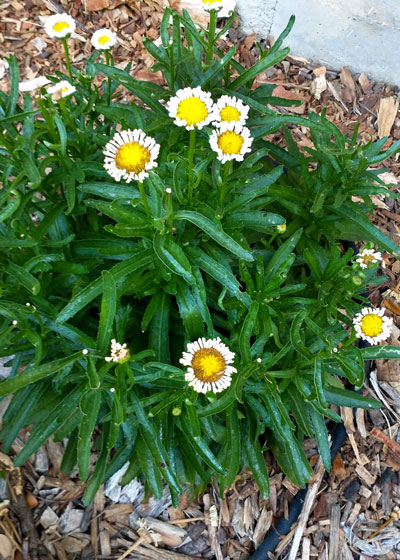
Answer: It’s probably too late to check for them, but I would guess thrips. They’re sliver-shaped insects about the size of 2-day whiskers that inhabit tight buds and suck juices out of the flower parts. They often bother mums, gardenias, magnolias and a whole host of other flowering plants. You can usually peel the buds apart and see the thrips. Systemic insecticides such as Imidacloprid applied three weeks ahead of bud opening will usually stop them. Otherwise, I guess we might chalk it up to drought and early heat.
QUESTION 3
WHY IS ZOYSIA SOD DYING JUST 15 MONTHS AFTER PLANTING?
Question: I had zoysia sod planted soon after the cold of February 2021. It came in this spring very nicely, but now it is struggling, seemingly from the heat. It is in the shade. It was very expensive. What can I do? LynnEtta M., Collin.
Answer: Unless it’s gotten too dry, zoysias can handle the heat we’ve been having. They are used in the “transition zone” where it’s too cold for bermudagrass and too hot for Kentucky bluegrass, so they are acclimated to high summer temperatures. What they can’t handle is shade. I wonder if your sod may be running out of steam due to lack of sunlight. Zoysias need 5 to 7 hours of direct sunlight daily to thrive. If they get very far below that the grass will become sparse. It depends somewhat on the variety of zoysia, but none is shade-proof. Without a photo that’s my best guess.
QUESTION 4
WHY ARE THERE BROWN SPOTS IN MY BERMUDA?
Question: I have problems with my bermudagrass. Spots turn silver and eventually brown. Fungicide and insect sprays don’t help. I water three times per week. Help! Bill W., Denison.
Answer: That may be the same cottony blight (Phytophthora blight) I wrote about last week. (See Q8 to Bobby J. from Justin https://neilsperry.com/2022/08/qa-ask-neil-august-4-2022/) Without a photo that would be my guess. It’s been very common this year in highly maintained bermuda.
QUESTION 5
CAN ENCIRCLING ROOTS BE CAUSING TREES NOT TO GROW WELL?
Question: I’ve had a bur oak and Shumard red oak for up to 10 years. They have not grown as well as some other nearby trees. Could these encircling roots be causing the problem? Michelle B., Newark, Tarrant Co.
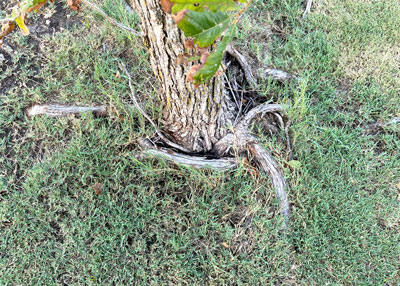
Answer: They can now, and they could certainly become an even more serious problem in the future if they begin to “grow into” the trunk itself. Trees have a habit of grafting their roots and trunks, multiple trunks and branches and trunks together. Often that can cause problems with transport of water and nutrients up to the leaves. In the case of your trees, this also suggests that there could be encircling roots down in the soil from when the trees were planted. If they came out of large pots they may have had roots that wound around and around inside the pot walls. Those roots could be stopping good root development into the adjacent soil. Or, it could be something as simple as these trees might have been allowed to get too dry at some point early on.
QUESTION 6
IS POA ANNUA RESISTANT TO PRE-EMERGENTS?
Question: I’ve been reading about herbicide resistance of annual bluegrass (Poa annua) with regards to pre-emergent weedkillers. I’ve been getting less than stellar results. What’s a gardener to do? Sylvia S., Frisco.
Answer: Clemson University (the highly respected Land Grant ag college for South Carolina) has an outstanding report that they update annually. We will leave the entire link here for you should you want to copy and paste it to save. https://hgic.clemson.edu/factsheet/annual-bluegrass-control/ They go into detail of the resistance, even to the point of suggesting two applications of pre-emergent granules out of different classes of products. I may be adopting that recommendation based on what the heat/drought trends yield in the next month. This is an outstanding report. There is no point in my trying to add anything to it.
QUESTION 7
WHAT CAUSES DEAD PATTERNS IN ST. AUGUSTINE THAT SEEM TO FOLLOW WHEELS OF LAWN MOWER?
Question: What causes the strange-looking dead patterns in my St. Augustine? They seem to follow the wheels of my mower. Anne G., Fort Worth.
Answer: That’s called “heat tracking.” I’ve had several questions about it this summer. That’s after going 6 or 8 years without any questions at all. Here is a short write-up from Michigan State. Granted, it’s on northern grasses, but the issue and how we deal with it are the the same.
QUESTION 8
WHAT IS WRONG WITH THIS DWARF BURFORD HOLLY?
Question: This dwarf Burford holly is turning yellow and losing its leaves. It’s being watered by hand. It’s on the western end of the row. Is it too dry, or is this a lack of iron? Terry C., Dennis.
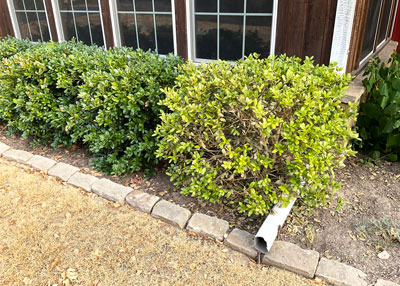
Answer: Definitely too dry. In fact, I hope it can be saved. The lawn looks like it’s toast, and I worry about the shrubs around the corner (oakleaf hydrangeas perhaps). This all is in serious need of a deep soaking immediately. Good luck!
QUESTION 9
CAN I TRIM A CRAPE MYRTLE THAT IS WEEPING?
Question: Our crape myrtle is taking on the appearance of a weeping willow. I need to prune its arching branches up at least 2 feet so I can walk beneath it. Is that OK to do? Jimmie S., Conroe.
Answer: Yes, but I surely wish I could see the plant to determine why it’s growing that way. A few varieties have a naturally arching habit. The one that comes to mind first is the graceful white selection from the USDA crape myrtle breeding program – one called Acoma. Its branches spray out like a fountain. It would be difficult to train it to be a tree that you could walk beneath without ruining its natural shape in the process. And the other thing I’d look for would be if this plant has been topped. When that’s done, the flower heads are quite large and heavy. They pull the branches down. When we don’t top crape myrtles their branches normally don’t weep. My recommendation in that case could possibly be to cut the trunks completely to the ground and retrain it as a tree with nice, straight trunks. Then you could “limb it up” to any height you needed. Oh, how I wish I had a photo. Hope that all helps.
QUESTION 10
CAN SEDGEHAMMER BE USED IN A DAYLILY BED?
Question: I’m using Sedgehammer in a nutsege-infested daylily bed. Do I need to worry about the daylilies? James J., Hutto.
Answer: I spent 45 minutes online looking at product labels of Sedgehammer and Image Kills Nutsedge and neither wants to brag about use in daylilies. As you probably know, they were primarily developed for use on turfgrasses. I found testimonials from well-meaning amateurs saying that they had used Sedgehammer without issue, but they admitted that they tried it on small spaces first to be sure they wouldn’t kill all their daylilies. That would be good advice on either product. Image has the broader label, but even it is limited when it comes to perennial gardens. You’re going to have to proceed at your own risk. There is plenty written about both products and daylilies online. You might want to spend an evening reading through it all, but just be careful to consider the source of the information and challenge whether you can trust it. Also, your time is running out, particularly with Image, before the season will be too far along.
QUESTION 11
WHAT SHOULD WE DO WITH VINCA MAJOR THAT LOST ALL ITS LEAVES IN THE HEAT?
Question: We had landscaping done last October. Vinca major was planted as a groundcover into an area that gets partial sun. It looked great through April, but once the heat hit it went downhill and lost all its leaves. What can we do? Laura T., San Antonio.
Answer: Vinca major is a shade-loving groundcover. Old-time Texas gardeners (like me) remember it as the prime plant (along with English ivy) that was grown beneath trees when the St. Augustine played out due to excessive shade. But the vinca has a huge problem each summer with leafrollers. They attack the plants and tie the vines’ leaves together to protect their larvae. Soon there are no green leaves – just barren stems. The plants look really ugly until late fall and early winter when new growth starts to emerge. By spring they’re beautiful again, only to start the cycle over again. Next year apply a systemic insecticide (Imidacloprid) about 3 weeks prior to the time that you saw the first browning. Since it was so early where you are, you might want to repeat the treatment 90 days later. Hopefully that will reduce the ugliness. You can always use a line trimmer to clean things up now.
QUESTION 12
WHAT IS CAUSING THE ODD GROWTH ON MY GOLD STAR ESPERANZA?
Question: My Gold Star Esperanza has bloomed all spring and summer. However, now the new growth on a big part of it is deformed and without a single flower. It has tons of little leaves that never develop fully. What is wrong?

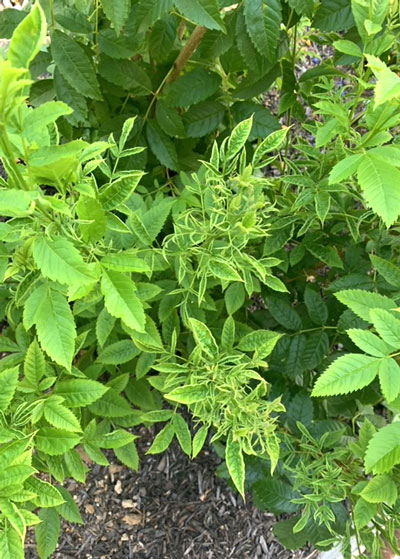
Answer: I’ve turned to the man who brought this plant to us in the first place. Greg Grant collected and researched selections and found and named Gold Star Esperanza. I forwarded your photos and question to him, and he and I both feel this looks like herbicide damage of some sort. Is it possible that some could have drifted onto the plants, either as you were spraying somewhere nearby (maybe in the walk) or from residue in a sprayer? I also wonder about any kind of gas leak since the damaged leaves are on the house side of the plants.
QUESTION 13
WHAT IS CAUSING THE YELLOWING AND DEAD AREAS IN ST. AUGUSTINE?
Question: My St. Augustine has yellow and dead-looking areas. I looked at your website, but I can’t figure which picture looks like my grass. Francis B., Fort Worth.
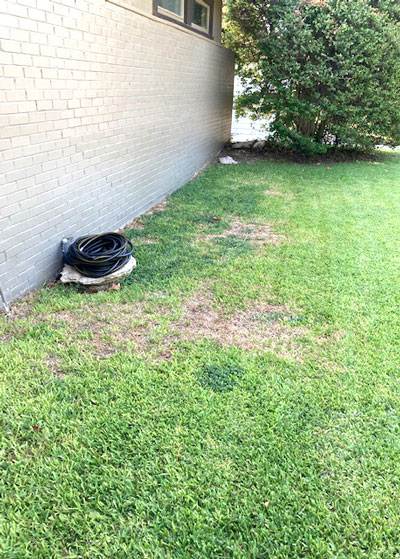
Answer: Owing to the time of year, I’m going to guess that it’s either chinch bug damage or gray leaf spot fungus. However, you can’t tell from this distance. You’re going to have to get down on your hands and knees to figure it out for sure. Scroll down at this archived page (https://neilsperry.com/2022/06/st-augustine-problem-solving-2/) to those two photos. You’ll see a close-up of the spots caused by gray leaf spot. You’ll also see photos of actual chinch bugs. I’m going to have to let you determine it from here.
QUESTION 14
WHAT IS WRONG WITH THESE VARIEGATED HYDRANGEAS?
Question: My variegated hydrangeas, planted this spring, are drying up. I water daily. What’s the cause? Chris R., Dallas.
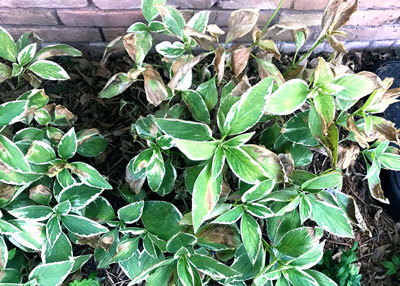
Answer: In one form or another, it’s moisture stress. The two most likely possibilities are that they’re getting sunlight for some part of the day. (They prefer shade.) Or they could have gotten too dry one or more times. Your best move at this point is to nurse them along until winter, then move them into a totally shaded location if they’re not in one already. And water them deeply when you do water them. They probably shouldn’t need to be watered daily – more like every other day once you get them in a good location.
QUESTION 15
WHAT CAN BE DONE ABOUT MEALYBUGS?
Question: I have a huge infestation of mealybugs. They have covered zinnias, almond verbena, hibiscus, blue mist, tomatoes – almost everything. I have sprayed many times. What will control them? Mike H., Waco.
Answer: It’s very unusual to have bad outbreaks outdoors. The drought may have led to a smaller population of natural predators. By the time they’re as bad as you describe it’s hard to get insecticides to all of the insects. You just have to be persistent. I’ve always had better luck using systemic insecticides, although that won’t work with tomatoes. Here is a fact sheet from Texas A&M. Dr. Merchant retired two years ago, but the information is still applicable.
QUESTION 16
WHAT CAN BE DONE FOR THE BARK OF MY ARISTOCRAT PEAR?
Question: I just noticed a problem with my 20-plus-year-old Aristocrat pear. What can I do about its bark? Connie P., Allen.

Answer: Ornamental pears have very narrow branch angles. That means that they pinch together, binding bark, moisture, dirt and debris between one another. As a result, very poor branch unions form and decay starts to develop. You’ll see ample examples of Bradford, Aristocrat and other ornamental pears that split right down their middles in wind or ice storms – or even just from the weight of their own branches. You’re seeing a variation of that happening with your tree. I know it’s not good news, but it’s something you needed to know. Keep watching carefully. There will come a day when you’ll need to have the tree removed. Don’t wait too long. (Sorry for the nature of my reply.)
